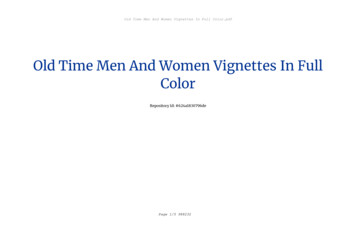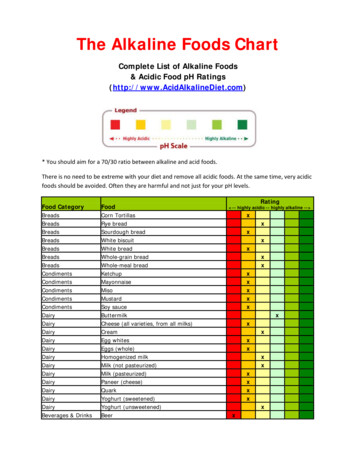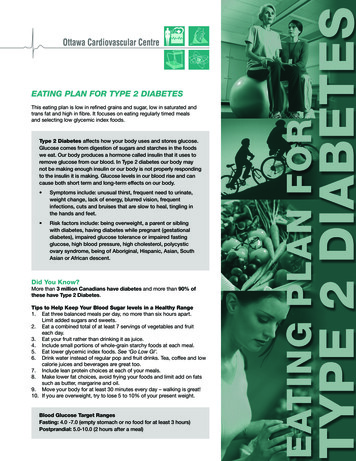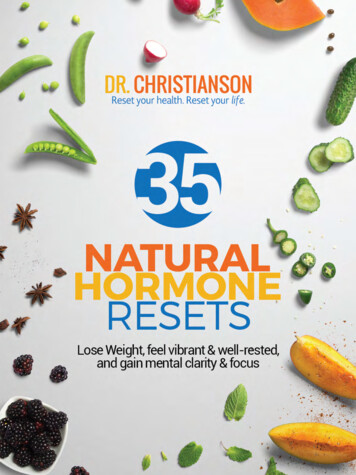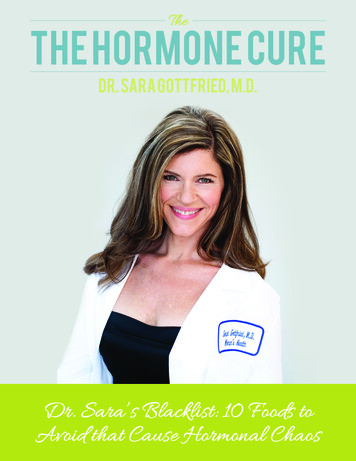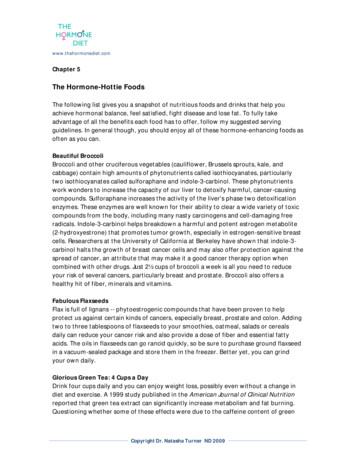
Transcription
www.thehormonediet.comChapter 5The Hormone-Hottie FoodsThe following list gives you a snapshot of nutritious foods and drinks that help youachieve hormonal balance, feel satisfied, fight disease and lose fat. To fully takeadvantage of all the benefits each food has to offer, follow my suggested servingguidelines. In general though, you should enjoy all of these hormone-enhancing foods asoften as you can.Beautiful BroccoliBroccoli and other cruciferous vegetables (cauliflower, Brussels sprouts, kale, andcabbage) contain high amounts of phytonutrients called isothiocyanates, particularlytwo isothiocyanates called sulforaphane and indole-3-carbinol. These phytonutrientswork wonders to increase the capacity of our liver to detoxify harmful, cancer-causingcompounds. Sulforaphane increases the activity of the liver's phase two detoxificationenzymes. These enzymes are well known for their ability to clear a wide variety of toxiccompounds from the body, including many nasty carcinogens and cell-damaging freeradicals. Indole-3-carbinol helps breakdown a harmful and potent estrogen metabolite(2-hydroxyestrone) that promotes tumor growth, especially in estrogen-sensitive breastcells. Researchers at the University of California at Berkeley have shown that indole-3carbinol halts the growth of breast cancer cells and may also offer protection against thespread of cancer, an attribute that may make it a good cancer therapy option whencombined with other drugs. Just 2½ cups of broccoli a week is all you need to reduceyour risk of several cancers, particularly breast and prostate. Broccoli also offers ahealthy hit of fiber, minerals and vitamins.Fabulous FlaxseedsFlax is full of lignans -- phytoestrogenic compounds that have been proven to helpprotect us against certain kinds of cancers, especially breast, prostate and colon. Addingtwo to three tablespoons of flaxseeds to your smoothies, oatmeal, salads or cerealsdaily can reduce your cancer risk and also provide a dose of fiber and essential fattyacids. The oils in flaxseeds can go rancid quickly, so be sure to purchase ground flaxseedin a vacuum-sealed package and store them in the freezer. Better yet, you can grindyour own daily.Glorious Green Tea: 4 Cups a DayDrink four cups daily and you can enjoy weight loss, possibly even without a change indiet and exercise. A 1999 study published in the American Journal of Clinical Nutritionreported that green tea extract can significantly increase metabolism and fat burning.Questioning whether some of these effects were due to the caffeine content of greenCopyright Dr. Natasha Turner ND 2009
www.thehormonediet.comtea, the researchers delved deeper and discovered that other properties besidescaffeine were behind the fat-burning benefits. While the caffeine does provide anenergizing boost, the tea also offers calming effects because it contains theanine, anatural compound that blocks the release of cortisol – great for conquering ab fat!Green tea also contains group of antioxidants called polyphenols useful for cancerprotection, free radical protection and cutting inflammation - so drink plenty of it regularly. It can help lower cholesterol and improve your blood sugar balance too.Revel in Red Wine: 4 Glasses a Week for Women; 7 Glasses a Week for MenThe French have had it right for centuries. Consumed in moderation, red wine canreduce the risk of type 2 diabetes, prostate cancer and heart disease. The antioxidantpolyphenols found in the skin and seeds of grapes -- especially catechins and resveratrol-- aid heart health, inhibit inflammation and help prevent the development of certaincancers. Resveratrol, a natural antifungal and antibacterial compound within grapes,may benefit nerves cells and assist in the prevention of Alzheimer’s and Parkinson’sdisease.According to researchers from Northwestern University Medical School, many benefitsof resveratrol are in fact due to its estrogenic properties. When consumed with or aftera meal, red wine is a good digestive aid. Despite all the wonderful benefits of red wine,note that you should stay away from this Hormone Hottie beverage if you have amedical condition worsened by alcohol, such as alcoholism, elevated triglycerides,pancreatitis, liver disease, uncontrolled hypertension, depression or congestive heartfailure.Get Your Daily Dose of Extra Virgin Olive OilOlive oil has been a vital component in a heart-healthy, Mediterranean-style diet for avery long time. The fresh news is the many additional benefits of olive oil that supportits designation as a Hormone Hottie Food.Olives and olive oil are rich in antioxidant compounds called polyphenols, which areknown to have anti-inflammatory, anti-cancer and anti-coagulant benefits. Olive oil alsoprovides a rich source of plant sterols to curb inflammation aid, hormonal balance andcontrol cholesterol. Though the various ways olive oil benefits weight loss is possibly themost exciting info I have to share. And these effects are not only because of its ability toreduce inflammation.When we include them in our daily diet, monounsaturated fats such as olive oilencourage the release of our appetite-suppressing hormone leptin. Olive oil, inparticular, has been shown to improve our sensitivity to insulin. In a study published inthe July 2007 issue of Diabetes Care, 11 subjects with insulin resistance and increasedabdominal fat used three different diets for 28 days. Each diet had equal calories butCopyright Dr. Natasha Turner ND 2009
www.thehormonediet.comdifferent compositions – one was a high-saturated-fat diet, the second was high incarbohydrates and the third was rich in monounsaturated fats. At the end of the 28-dayperiod, researchers measured the effects of each diet on body-fat distribution, insulinresistance and adiponectin levels. You may recall I first spoke about adiponectin inChapter 3. It is a hormone released by our fat cells and known to improve insulinsensitivity, reduce inflammation and offer us protection against obesity and metabolicsyndrome.Can you guess the results? Of the three diets, the diet rich in olive oil showed the bestoutcome, preventing not only belly fat accumulation but also the insulin resistance anddrop in adiponectin typically seen in people who eat a high-carbohydrate diet.Another study in the Journal of the American College of Nutrition (October 2007) foundcomparable results when using a similar study design. Again, weight maintenance wasbest with the olive-oil-rich diet, especially when this fat was consumed at breakfast.Improved fasting insulin, blood sugar balance (after meals), good HDL cholesterol andother signs of insulin balance were noted in the 12 insulin-resistant subjects who tookpart in the study.But here’s the really amazing tidbit. Besides helping us lose weight, balance ourhormones, reduce inflammation and keep insulin under control, olive oil also breaksdown fat cells we already have. In a study published in the British Journal of Nutrition(December 2003) researchers fed three different diets to rats – one rich in olive oil,another high in polyunsaturated soybean oil and a third high in saturated fat from palmkernel oil. The results showed increased breakdown of fats in fat cell with the olive oilrich diet. Interestingly, the opposite effect was noted with the diet high in soybean oil,which is listed in Chapter 15 as one of the Hormone-Hindering food we should avoid100% of the time. Based on these results, staying away from soy bean oil is definitely agood thing.Enjoy AvocadoAvocados contain glutathione, one of the most potent antioxidants and disease-fightingagents available to us. These rich-tasting fruits are also high in heart-friendly vitamin Eand potassium. Back in 1996, avocados gained publicity as a healthy food when a studylooking at the health benefits of daily avocado consumption was published in theArchives of Medical Research. During the study, 45 people ate avocados every day for aweek. They experienced an average 17% drop in total blood cholesterol and theircholesterol ratio also changed in a healthy way: LDL went down and HDL went up.Researchers now know that avocados are rich in beta-sitosterol, a natural substanceshown to significantly lower blood cholesterol levels. In a review article published in theDecember 1999 issue of the American Journal of Medicine, researchers pointed out thatbeta-sitosterol was shown to reduce cholesterol in 16 human studies. Anotherwonderful benefit of beta-sitosterol is that it helps to balance cortisol, even duringCopyright Dr. Natasha Turner ND 2009
www.thehormonediet.comexercise. It may also help to restore low DHEA and decrease the inflammation typicallyassociated with the stress of intense exercise.Unfortunately avocados earned an undeserved bad rap during the low-fat craze becausethey are high in monounsaturated fats. But remember, you need fats – healthy fats – forfat loss. Besides offering an excellent source of healthy fat, avocados are also rich inantioxidants that are great for your complexion.An Organic Apple a DayWith all that fiber and antioxidant power, an apple a day truly can help keep the doctoraway. Apples contain quercetin, a flavonoid antioxidant and natural antihistamine. Likemany other flavonoids, quercetin also has phytoestrogenic properties. Finnishresearchers finally completed a study in September 2002 in which 10, 054 people ate anapple day beginning in 1966! Published in the American Journal of Clinical Nutrition, theresults showed that this simple dietary habit reduced the risk of almost every chronicdisease associated with aging, including osteoporosis, heart disease, cancer, stroke, type2 diabetes and asthma. Numerous other studies support the cancer-protective benefitsof quercetin for the prostate, lung, breast and skin. For all these reasons and more, anapple a day is part of The Hormone Diet nutrition plan.Super Sexy SalbaSalba is a gluten-free ancient grain that can be added to just about any food. It hasbeen studied extensively by Dr. Vladimir Vuksan, an associate professor ofendocrinology and nutritional Sciences at the University of Toronto Faculty of Medicine.It is world’s first and only medically patented food and its nutritional profile is quitesomething, I must say! On a per gram basis, Salba is touted to be: The highest source of omega-3's in nature – with 65% of its total fat is fromomega-3 fatty acids The highest source of fiber in nature – 35% (90% of which is insoluble and 10% issoluble) Abundant in the minerals magnesium, potassium, folic acid, iron and calcium A complete source of all essential amino acids and bio-available protein A great choice for a carbohydrate-conscious eater. The carbs in Salba aremostly insoluble fiber, which means it has few calories and is very beneficial fordigestionJust 3 ½ oz. (100 grams) of Salba offers an amazing 20 grams of omega-3s, theequivalent of 1 ¾ lbs. (790 grams) of Atlantic salmon. Wow! (Source:www.sourcesalba.com)And then there are the hormonal benefits. Salba stabilizes blood sugars, manages theeffects of diabetes, improves insulin sensitivity and aids symptoms related to metabolicsyndrome, including imbalances in cholesterol, blood pressure and high blood sugarCopyright Dr. Natasha Turner ND 2009
www.thehormonediet.comafter meals. Salba is highly anti-inflammatory and reduces high sensitivity C-reactiveprotein, a blood marker of inflammation. This wondrous little grain also contains highamounts of tryptophan, the amino acid precursor of serotonin and melatonin.Sure sounds like we should all be savouring Salba every day, although it actually has verylittle taste – yet another fantastic feature that makes it so easy to blend with otherfoods.Go Nuts: 10 – 20 Almonds or 1 Tbsp. of Almond Butter DailyRaw nuts such as almonds and walnuts are an excellent choice for healthful, fillingsnacks. Nuts are not only rich in healthy oils, zinc, selenium and vitamin E but they alsoprovide a mix of protein and carbohydrate all in one, making them a good option for thecarbohydrate-conscious eater looking to lose weight. (But remember, just a smallhandful will do.) The healthy fats in nuts also stimulate leptin release, which helpscontrol your appetite. Snacking on nuts or adding them to salads or oatmeal five times aweek is proven to reduce your risk of type 2 diabetes and to lower cholesterol too.Like avocados, most nuts are an excellent source of the plant sterol beta-sitosterol.Almonds, in particular, contain protein, fiber, plant sterols and several other hearthealthy nutrients. Almonds are also known to slow the absorption of carbohydrates inthe body, which may help with diabetes management. In addition to loweringcholesterol levels and reducing the risk of coronary heart disease, researchers at theUniversity of Toronto found that eating almonds may reduce the impact ofcarbohydrate-rich foods on blood sugars. Their data highlights that eating almondstogether with carbs slows the rise in blood sugar, which may increase satiety and helpkeep insulin levels from fluctuating. So if you absolutely have to grab some cheesecake, Iguess you should have a few almonds with it!Here’s a surprising fact about walnuts. Research from the University of Texas HealthScience Center published in the September 2005 issue of Nutrition, showed that walnutsare a source of melatonin. You will recall that melatonin improves our sleep but it alsooffers antioxidant protection. So walnuts just might be your secret weapon againstsleeplessness nights, as well as cancer, Parkinson’s disease, Alzheimer's disease andcardiovascular illness.And let’s not forget about pecans, the sole nut cited by the US Department ofAgriculture in their list of "Top 20 Fruits, Vegetables and Nuts" for sources of foodantioxidants. Loma Linda University also published research results in 2006 showing thatadding just a handful of pecans to a balanced diet could help manage our bad LDLcholesterol. Good news for nut lovers, because pecans sure are tasty.Soy: a Serving Once a DayCopyright Dr. Natasha Turner ND 2009
www.thehormonediet.comBone density, hormonal balance and cholesterol levels change as we age, but a dailyserving of soy can help lower cholesterol, keep bones strong, improve heart health,protect the prostate and ease the symptoms of menopause. The therapeutic effects ofsoy products come from the phytoestrogens naturally present in soybeans. Just a cup ofunsweetened, organic soy milk or yogurt, a handful of soy nuts or a palm-sized servingof tempeh can do the trick. Research from the University of Illinois also suggests soyprotein may help to increase metabolism, manage weight and limit the growth of fatcells.Refreshing Reverse Osmosis WaterOur skin certainly needs healthy fats to stay supple, but water is the key to preventingfine lines and a dehydrated appearance. Believe it or not, our skin, like most tissues inour body, is mostly water. Sufficient water is crucial for preventing joint stiffness, weightgain, headaches, decreased athletic performance and poor recovery after exercise. Ingeneral, the eight cups-a-day guideline is sufficient, but you should definitely drink morewhen you exercise or spend time in the sun. Dehydration also increases the release ofNPY, which stimulates our appetite. So next time you feel hungry, drink a glass of waterfirst to be sure your body isn’t tricking you into consuming extra calories. If youpurchase water, look for reverse osmosis or pure spring water in glass bottles ratherthan plastic. Also, be aware that distilled water is void of essential minerals.Powerful Whey Protein IsolateThis powdered supplement is the most bio-available source of protein we can get,making it a great addition to smoothies and shakes. Your liver loves whey proteinbecause it offers us a concentrated source of glutathione, just like lovely avocados.Whey has been proven to promote fat loss, preserve muscle tissue, enhance immunity,aid insulin sensitivity and support recovery after exercise. It is also a source oftryptophan, which can help raise serotonin and combat stress.Bountiful BerriesBerries have gained plenty of good publicity as a super food choice for protectionagainst free radicals and inflammation, both of which accelerate aging and contribute todiseases such as cancer and Alzheimer’s. Blueberries, in particular, can protect usagainst sun damage and support eye health. They are high in fiber, low in sugar andcontain a potent dose of proanthocyanidins, which are beneficial for skin, cognitivefunction and cardiovascular health.Most of us are familiar with blueberries and other berries typically found in our localsupermarket. But have you ever heard of the acai berry? Researchers at the Universityof Florida have recently shown these tropical berries to be even higher in antioxidantsthan blueberries. How about goji berries? They’re also one of my new favorite snacks.Copyright Dr. Natasha Turner ND 2009
www.thehormonediet.comVery high in fiber and antioxidants, they also contain an amazing four grams of proteinper serving and a bit of iron too! A tablespoon or two of goji berries mixed with low fat,organic cottage cheese is a fantastic option for a snack.Sprinkle on the CinnamonI encourage you to add cinnamon to your food and hot drinks as often as possible notonly because it tastes so nice but also because it offers wonderful insulin-balancingeffects. A study published in the journal Diabetes Care (December 2003) showed thatcinnamon may cause muscle and liver cells to respond more readily to insulin. Betterresponse to insulin means better blood sugar balance and, therefore, less insulin in yourbody. Cinnamon also seems to reduce several risk factors for cardiovascular disease,including high blood sugar, triglycerides, LDL cholesterol and total cholesterol. Just a ½teaspoon a day for 30 days is enough to significantly improve your insulin response andtrim your waistline. I add it to my coffee, and you should too.Beneficial Oat BranOats are a good source of many nutrients including vitamin E, zinc, selenium, copper,iron, manganese and magnesium. They are also packed with protein and fiber, whichcan help balance blood sugar and insulin while reducing cholesterol and heart-diseaserisk. According to the American Cancer Society, the phytochemicals in oats may alsohave cancer-fighting properties. They make a nice, comfy hot breakfast and can easilybe added to many recipes.Be Big On BuckwheatBuckwheat offers us an alternative to wheat, one of the most highly allergenic foods andthe grain we tend to most commonly overeat. Buckwheat is a gluten-free grain, makingit an excellent choice for those with celiac disease, gluten sensitivities, food allergies orfor anyone undertaking an anti-inflammatory detox. It can be used as an alternative torice or served as porridge.Buckwheat is higher in protein and fiber than other grains. Recall the benefits ofprotein; it assists with healthy immunity, healing after exercise, maintaining stableblood sugar balance and encouraging fat loss. Buckwheat is also lower on the glycemicindex and results in less insulin release after consumption. It’s known to lowercholesterol and is a rich source of magnesium. Rich in anti-inflammatory flavonoids(especially rutin, which tonifies veins and is useful for treating and preventing spider orvaricose veins), buckwheat is a beautiful choice for bolstering the health of our heartand blood vessels.Say Yes to Plain Organic YogurtCopyright Dr. Natasha Turner ND 2009
www.thehormonediet.comAs a natural source of probiotics (there’s more to come about these critters in Chapter10), yogurt promotes good digestion, restores healthy bacterial balance in the gut, aidsthe metabolism of estrogen and supports healthy immunity. Studies have shown thatjust half a cup a day can lessen the frequency and severity of colds and flus.Besides reducing the uncomfortable abdominal bloating often associated with unsettleddigestion, yogurt may also help trim your waistline by encouraging weight loss. Recentreports showing the benefits of high-calcium, low-fat dairy products for weight loss iscertainly welcome news for dieters and dairy farmers alike. Plus, you may recall thebenefits of high water-content foods I mentioned in the previous chapter. Yogurt is agreat example of a helpful, volumizing food that sends the strong message to your brainthat you’re full. If you are lactose intolerant or have other sensitivities to dairy,however, you should leave this one out of your diet.Pour on the PomegranateResearchers at the University of Wisconsin have shown that pomegranate extract hasanti-cancer, anti-inflammatory and antioxidant properties that are effective insuppressing cancer of the skin, breast and colon. New research indicates thatpomegranate may be particularly helpful for the prevention of breast cancer. The mostpowerful estrogen in the body, estradiol, plays an important role in the origin anddevelopment of breast cancers, most of which are hormone-dependent in their earlystages. Pomegranates possess natural compounds that inhibit the enzyme in women’sbodies that converts the weak estrogen, estrone, into its most potent metabolite,estradiol. High amounts of this enzyme can be an indicator of adverse prognosis inwomen with estrogen-receptor-positive breast tumors. As a result, pomegranate offerssome hope for possible therapeutic interventions in breast cancer. Guys, it’s alsoshowing promise for prostate cancer protection for you too. Pomegranate juices orseeds are a great way to enjoy the healthful benefits of this tasty ruby-red fruit.Spice up Your LifeHerbs and spices certainly add zesty flavor to our meals, but many also offer antiinflammatory, antioxidant, anti-aging, immune-enhancing, and hormone-balancingeffects. Garlic, rosemary, thyme, turmeric, cumin, curry and cayenne pepper areparticularly beneficial.Turmeric (also called curcumin) is one of my personal favorites because it naturally cutsinflammation, pain and swelling. According to trials conducted at Johns HopkinsUniversity School of Medicine in 2006, a combination of turmeric and quercetin, apowerful antioxidant found in onions, apples, and cabbage, can help shrink painful colonpolyps. Those who participated in this study experienced a 60% drop in the number ofpolyps along with 50% shrinkage of polyps that remained. In a 2006 study published inCopyright Dr. Natasha Turner ND 2009
www.thehormonediet.comthe Journal of Alzheimer's Disease, researchers at UCLA also found that turmeric helpsclear the brain of the plaques that are characteristic of the disease. Incredible!Ginger is another fabulous herb proven to prevent and treat nausea from motionsickness, pregnancy and chemotherapy. It’s a potent antioxidant that works by blockingthe potentially nauseating effects of serotonin on the gut. Like turmeric, ginger alsopossesses natural anti-inflammatory benefits and may improve blood flow. A studyconducted at the University of Miami showed ginger extract also had a significant effecton reducing the pain of osteoarthritis. Similarly encouraging results were found in a2006 study at the University of Michigan Comprehensive Cancer Center. Theseresearchers found powdered ginger killed ovarian cancer cells just as well or better thantraditional chemotherapy.Delicious Dark Chocolate: a One-inch Square DailyA research team from the University of Helsinki, Finland, asked pregnant women to ratetheir stress levels and document their chocolate consumption. Guess what they found?Six months after birth, the mothers rated their infants' behavior in various categoriesincluding fear, soothability, smiling and laughter. The babies born to women who hadeaten chocolate daily during pregnancy smiled and laughed more and were more active.Even the babies of stressed women who had regularly consumed chocolate duringpregnancy showed less fear of new situations than babies of stressed moms-to-be whoabstained. Awesome news for new moms and chocoholics!Who says we can’t indulge a little and improve our health at the same time? This tastytreat boosts our endorphins and also contains tryptophan (a building block of serotonin)and the brain chemical phenylethylamine known to promote our feelings of attraction,excitement and love. But new research shows yet another chemical is involved in thehappy little high we get from chocolate. Dr. Daniele Piomelli, a neuroscientist andprofessor of pharmacology at the University of California, Irvine, suggests that chocolateinfluences anandamide, a chemical that targets our brain much the way the activeingredient (THC), in marijuana does. Chocolate contains anandamide, as well as twochemicals known to slow the breakdown of this neurochemical. So, it might work byprolonging the action of this natural stimulant in our brain.Chocolate is also good for our heart and blood vessels. According to a study published inthe July 2007 edition of the Journal of the American Medical Association, eating a smallportion of dark chocolate each day can lower blood pressure without packing on extrapounds. Dark chocolate's heart-healthy effects are thought to come from flavonoids,natural compounds in cocoa beans that give dark chocolate its bittersweet taste. Darkchocolate is richest in flavonoids, whereas white chocolate contains none. FlavonoidsCopyright Dr. Natasha Turner ND 2009
www.thehormonediet.comhave been shown to inhibit blood clot formation, ease constriction of blood vessels andslow the oxidation of LDL cholesterol.Food for Your ThoughtsBlueberries, tea, grapes and cocoa enhance memory in mice, according to researchpublished in The Journal of Neuroscience (May 2007). The effects of these foods wereintensified when the mice also exercised regularly. The compound common to all thesefoods is epicatechin, a flavonol that has already been shown to improve cardiovascularfunction and increase blood flow in the brain. Flavonoids are also found in somechocolate, so maybe we should snack on a square before our workouts for an extrabrain boost!Which Red Wine Should You Chose?Researchers at the University of California, Davis, tested a variety of wines to determinewhich types have the highest concentrations of flavonoids. They found dryer wines suchas cabernet sauvignon to be the flavonoid favorites, followed closely by petit syrah andpinot noir. Merlots and red zinfandels were found to have fewer flavonoids than theothers.Copyright Dr. Natasha Turner ND 2009
rich diet. Interestingly, the opposite effect was noted with the diet high in soybean oil, which is listed in Chapter 15 as one of the Hormone-Hindering food we should avoid 100% of the time. Based on these results, staying away fr
